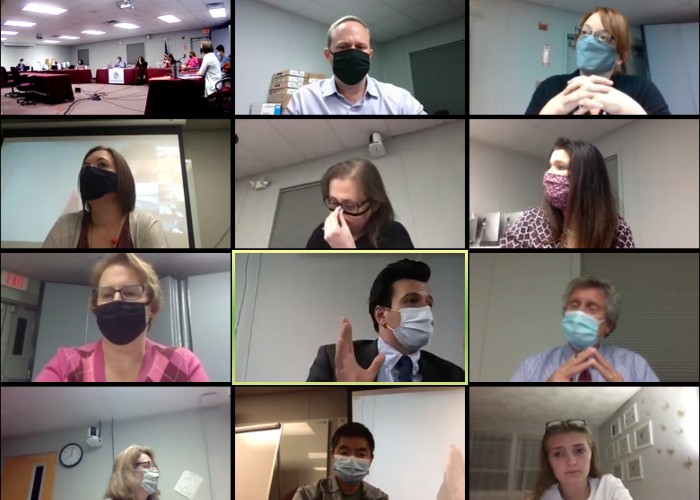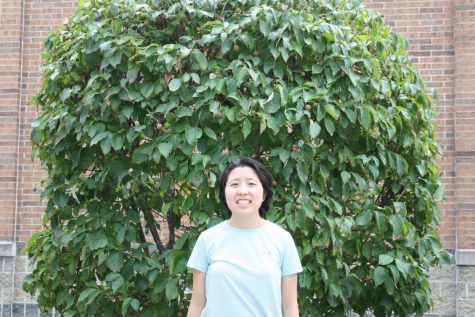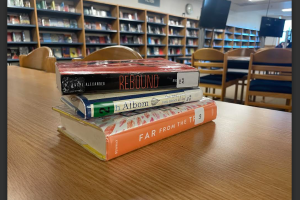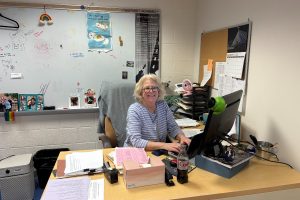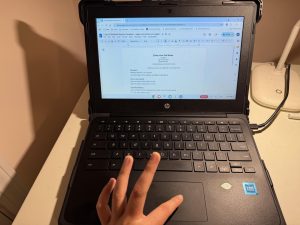9/14 school committee meeting talks air quality and votes for MIAA-proposed sports plan
The School Committee gathered on Monday, September 14 alongside Facilities Director Paul Fox and Athletics Director Jeff Bunyon to discuss air quality, diversity, and voted for the MIAA-proposed sports plan.
September 18, 2020
On Monday, September 14, the school committee met to discuss the town wide approach towards air quality maintenance, talk about diversity and inclusion updates, and voted in favor of the MIAA proposed sports plan for the year.
After early discussion reiterating bus route information covered in previous meetings as well as pod assignment clarifications, Superintendent Bill Olsen and facilities director Paul Fox broadcasted in detail safety protocols and their plan for monitoring the air quality at the school.
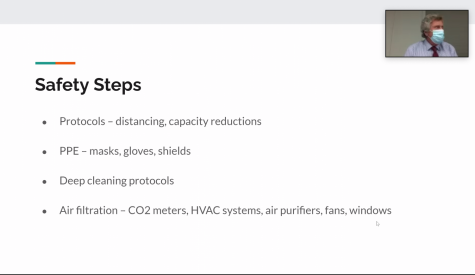
The main safety steps that the school district will be implementing can be split into protocols, both distancing- and deep cleaning-related, personal protection, and air filtration.
One of the main protocols that Olsen has reiterated is that students will be kept 6-feet apart per CDC guidelines, as opposed to the DESE-proposed guidelines of 3-feet at all times. In addition, one custodian on the night shift will be reassigned to the day shift so that even during school hours, there will be more custodians sanitizing commonly-touched surfaces. Cleaning logs will also be kept in the bathrooms.
In terms of personal protection, students will have access to extra masks and gloves as needed at their disposal, and there will be hand sanitizing stations in hallways and classrooms.
Olsen then went on to talk about air filtration procedures. He started by explaining the reasoning behind air quality testing that happened this summer, and how ideal carbon dioxide levels are monitored in order to keep students protected.
“We have purchased two detectors because we needed to have an air quality test done in every school and assessed the carbon dioxide level. […] We needed a baseline measure from which to assess any of the fine-tuning for the HVAC systems. […] What we want to do is make sure is that we don’t reach a threshold level […] because that’s an indication that […] the air exchange is not adequate,” Olsen said.
In order to monitor these carbon dioxide levels, Fox explained that either the head custodian or principal will be going to classrooms around the school with portable handheld carbon dioxide detectors to make sure that the levels of carbon dioxide are not hitting threshold levels that could potentially be dangerous.
For nurses and other staff with self-contained offices without windows, including the REACH program, special education program, and the preschool, medical-grade air purifiers have been purchased. These air purifiers would be especially in rare emergency situations where the HVAC systems may not be working.
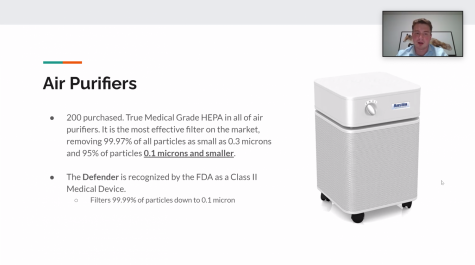
Fox also explained how specifically the Austin air purifiers [pictured on the right] have been proven to help with COVID-19.
“One important thing to point out is that the coronavirus is cited as being 0.12 microns. This unit [the Austin has the ability to capture and kill microns as small as 0.1. So, it will be effective against COVID-19,” Fox said.
Additionally, MERV-13 filters, which are higher capacity filtration capacity filters made of the same material as N-95 masks, have been bought by the school. There are also MERV-8 filters already built into the HVAC systems in the buildings, but these MERV-13 filters will serve as an extra safety measure.
In general, filters will be changed twice or three times per schoolyear, or as seen fit by Olsen and Fox.
Afterwards, Fox went on to give a brief, high-level explanation of the two main HVAC systems throughout the school district, unit ventilators and air-handling units. Both of these units employ a variety of filters to take out smog and debris from outside air and heat incoming air if needed before deploying it into the building. As for exhaust, both systems also have a tendency to mix exhaust back in with outside air for efficiency purposes; however, Fox and Olsen have tried to reduce this as much as possible.
After the air quality policy throughout the WPS district was explained, the school committee addressed community concerns about blackface and yellowface at WA.
Traditionally at WA, during the spirit rally each year, seniors will paint their faces with black and silver facepaint. However, the team behind Westford Coalition for Change put together a petition which addressed the opinions of many students and parents that the “intention may not be racially motivated, but the symbol [blackface] is still inherently racist”. Therefore, “a permanent ban of this racist symbol is necessary”. This petition also addresses yellowface at WA, which had “been done at WA for the WATA play ‘Miss Saigon'”.
Last week, the Westford Coalition for Change met with the Diversity, Equity, and Inclusion (DEI) Policy Subcommittee to call for changes to school policy regarding blackface and yellowface.
DEI and school committee member Chris Sanders explained that this is still being talked about and that they are working through this issue together, but the general idea was that existing policy may likely cover these concerns.
“I’ll say, and again, this is one meeting, and it’s still early, and I think there’s a lot more conversations that can be had, but the sense that we had was that it should be covered by existing policy. We have student harassment policy, we have staff harassment policy, we have dress code policy, and […] the takeaway from those is that yes, if this is something that be construed in an offensive way then that’s a violation of those policies,” Sanders said.
School committee member Gloria Miller then when on to stress that discussions about diversity-related issues are ongoing, and that bringing more voices to the platform is important for lasting change.
“When it comes to subjects like this, it’s not going to be solved overnight, and it’s not going to be solved by three people on a subcommittee. […] The more buy-in we have from a diverse group of people, the better understanding we will have on the issue and the more concrete solutions we will come up with,” Miller said.
The last main agenda item for the school committee was the conversation that involved in the vote and approval of the MIAA sports plan for the upcoming school year at the high school level.
Athletics Director Jeff Bunyon gave the school committee the same presentation that was shown to all superintendents, principals, and school committees in the MIAA regarding safety protocols and procedures, as well as the general structure of how sports will operate. These guidelines are also aligned across the DCL, as the DCL gathered to discuss these protocols in addition to adding extra safety guidelines as well.
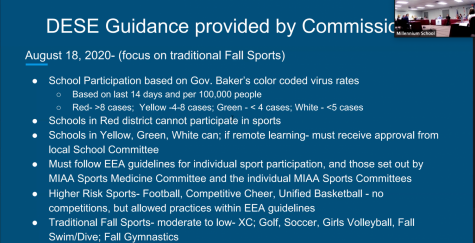
To start off, what determines whether or not a school is able to compete in the MIAA is the town’s coronavirus rate designation by the state, with the designations being white, green, yellow, and red in order from least to severe to most severe. Any town with a designation of red will be forbidden to compete in sports. Westford currently has a green designation and is allowed to compete, but if that designation changes to red, then WA will have to notify the other teams of the DCL and will therefore not be allowed to compete.
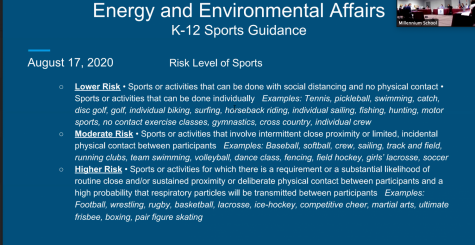
Next, the MIAA assessed which sports were low-, moderate-, and high-risk sports respectively. Low- and moderate-risk fall sports include cross-country, golf, soccer, girls’ volleyball, fall swim and dive (for Acton-Boxborough and Boston Latin), fall gymnastics, and field hockey (not listed in the picture on the right). High-risk sports including football, competitive cheer, and Unified Basketball will be pushed to a later season.
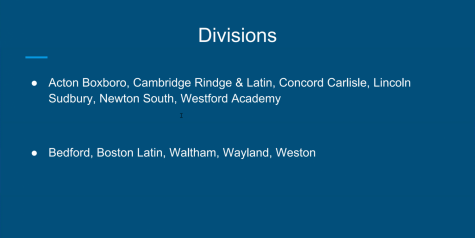
Then, in terms of which teams will compete against each other, the DCL has decided to split into two pods (shown on the right). Teams will be competing within these pods except for one crossover week where they may compete with a team from the other pod. Additionally, in order to minimize contact tracing, one school will only play one other school each week.
“We’ll be playing the same town the entire week, all of our teams. […] Basically, if we were scheduled to start to compete with Carlisle, we’d be playing them the entire week in all of our schools. So, if there was any contact tracing that was needed, we would be in a much better position to trace any contact,” Bunyon said.
As for the pod divisions, individual districts were to vote on the sports plan for the year, and school committees in every district of the DCL have voted for this approved MIAA and DCL-approved plan. Newton South and Westford were the last schools to take a vote, and Newton South also voted on Monday night in favor of this plan.
The structure of the different seasons has also changed. Although traditionally there are three sports seasons for the year, a fourth season has been added in order to accommodate for fall sports that are currently unsafe to play but will hopefully be safe to play later in the school year.
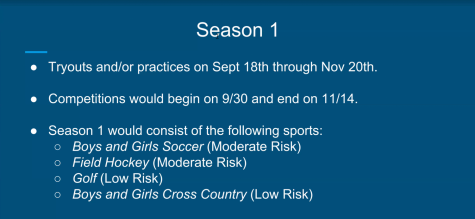
The first season will run from September 18 to November 20, though the unofficial start date to tryouts and practices will be on September 21 due to Rosh Hashanah. Competitions will officially begin on September 30, and the season will likely end with an in-pod tournament sometime between November 14 and November 20. For WA, the sports that will be competing will include boys’ and girls’ soccer, field hockey, golf, and boys and girls cross country. Crew is not included in the regular schedule; however, students will still be able to partake in crew through Westford Community Rowing, which will be holding clinics as part of their fall program.
The second, third, and fourth seasons will run November 30-February 21, February 22-April 25, and April 26-July 3, with the DCL meet being scheduled for June 25.
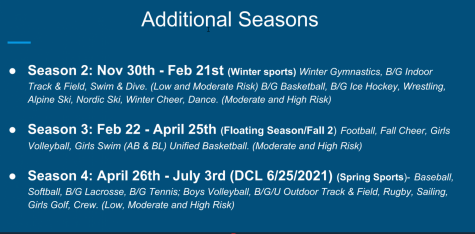
The sports that will compete for each of the last three seasons are listed in the picture on the left.
The third season will serve as a floating season and will include the sports that did not get to compete during the regular fall season—football, fall cheer, girls’ volleyball, girls’ swim, and Unified Basketball. Although girls’ volleyball and fall girls’ swim were assessed to be moderate risk sports, they will also be competing during this season.
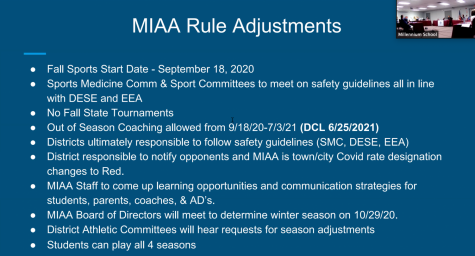
In addition to a different structure, there are also many different adjustments to the MIAA rules. Because of coronavirus risk, there will be no fall state tournaments. Students are usually allowed to play all three seasons during a regular school year, so during this school year, students will be allowed to play all four seasons.
A lot of the burden falls on the individual school districts as well, as they are responsible for notifying the MIAA and other teams if the town’s coronavirus rate designation changes to red in addition to enforcing MIAA protocols and guidelines.
The schedule for games will also be changing this year, as well as what it looks like to travel to a different team. Bunyon explained how this would look different between varsity and sub-varsity teams, as well as how in-town competitions would be held more frequently.
“The varsity would be playing interscholastic competition on Wednesdays and Saturdays, and sub varsity teams will be playing the interscholastic competition just on Saturdays. Midweek, whether it’s Wednesday or Thursday, we will have scheduled inter-squad scrimmages between just our teams. They’ll have an inter-squad scrimmage game with an official, and it will be scheduled,” Bunyon said.
One important detail to note is the option for out-of-season coaching, which lasts from the beginning of the year up until July 3. Each coach who wishes to do out-of-season coaching must come up with a plan and submit it to Athletics Director Bunyon for approval. These plans should make it so that out-of-season is available to both varsity and sub-varsity players, strictly optional, at most twice per week, skill-based (no playing in other outside-0f-school leagues), and should not conflict with the start of a new season.
However, Principal Antonelli must first approve of out-of-season practices in order for this to happen, and that has yet to be decided on.
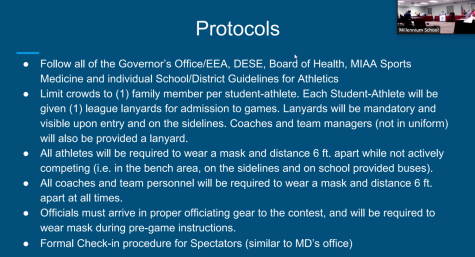
In terms of safety protocols, the MIAA and DCL have implemented guidelines for students to follow during practices and games in order to stay safe and minimize contact tracing.
In general, students and coaches are required to wear masks, bring their own hand sanitizer, and social distance as much as possible when not on the field playing.
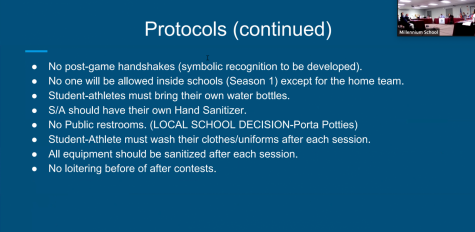
Additionally, students are required to not only social distance on the field but to come prepared to stay safe. Students are also encouraged to bring their own equipment and required to bring their own water bottles, in addition to sanitizing their equipment and washing their uniforms after every practice and game.
One major safety protocol that will be implemented is the limitation on the number of spectators that can be present. Each student will be allowed to bring one parent to the game so that in each game, there will be a maximum of 25 spectators from the home team and 25 spectators from the away team. In order to regulate this and make sure there are not too many people in the stands, lanyards will be given to each player to give to their families. The family member coming to the game will then use that lanyard as an entrance ticket.
Another important change to note is that locker rooms will not be used. In the case that there is inclement weather, there will be designated areas for students to take cover.
Ultimately, when asked about the possibility of late buses for students going to practice, Bunyon emphasized that his goal this year was to make sure that everyone felt included, and that every sport is represented in the upcoming year.
“If there’s a situation we need to look at, for inclusion, I want to make sure that we do it. Again, I want all student-athletes competing,” Bunyon said.
Click here to view the full slideshow for athletics and click here to watch the entire school committee meeting via the Westford CAT.

